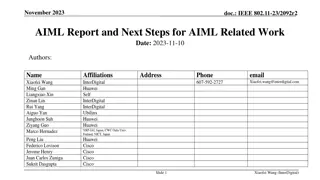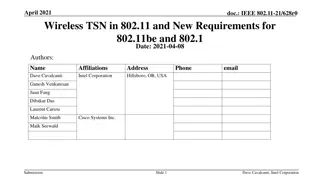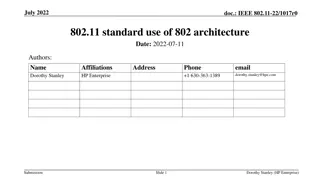IEEE 802.11-17/0029r4 WUR Usage Model Document
This document, dated January 2017, outlines usage models for wake-up radio WLAN standard. It includes details on various usage models like Smart Home, Warehouse, Outdoor Cattle Farms, Sensor Network Synchronized Wake Up, Wearable Devices, Moving Goods Tracking, and more. The document also explains terminology related to usage models and provides insights into applications, environments, traffic conditions, and use cases.
Download Presentation

Please find below an Image/Link to download the presentation.
The content on the website is provided AS IS for your information and personal use only. It may not be sold, licensed, or shared on other websites without obtaining consent from the author.If you encounter any issues during the download, it is possible that the publisher has removed the file from their server.
You are allowed to download the files provided on this website for personal or commercial use, subject to the condition that they are used lawfully. All files are the property of their respective owners.
The content on the website is provided AS IS for your information and personal use only. It may not be sold, licensed, or shared on other websites without obtaining consent from the author.
E N D
Presentation Transcript
Jan 2017 doc.: IEEE 802.11-17/0029r4 WUR Usage Model Document Date: 2016-01-19 Authors: Name Ross Jian Yu Affiliations Huawei Technologies Address Phone email ross.yujian@huawei.com David Xun Yang Huawei Technologies yunbo.han@huawei.com Yunbo HAN Huawei Device yong.chengyong@huawei.com Yong CHENG Huawei Device ping.fang@huawei.com Ping FANG Huawei Device dzm.dingzhiming@huawei.com Zhiming DING Huawei Device Shimi Shilo Huawei Technologies Avi Weitzman Huawei Technologies Genadiy Tsodik Huawei Technologies yangyunsong@huawei.com Yunsong Yang Huawei Device Peter Loc Huawei Technologies Osama Aboul-Magd Huawei Technologies shahrnaz.azizi@intel.com Shahrnaz Azizi Intel Corporation minyoung.park@intel.com Minyoung Park Intel Corporation Submission Slide 1 Ross Jian Yu, Huawei Technologies
Jan 2017 doc.: IEEE 802.11-17/0029r4 Authors (cont d): Name Affiliations Address Phone email Xiaofei Wang Interdigital Xiaofei.Wang@InterDigital.com Tomo Adachi Toshiba Corporation tomo.adachi@toshiba.co.jp Minho Cheong Newracom minho.cheong@newracom.com Pooya Monajemi Cisco pmonajem@cisco.com Kaiying Lv ZTE Corporation lv.kaiying@zte.com.cn Bo Sun ZTE Corporation sun.bo1@zte.com.cn Nan Li ZTE Corporation li.nan25@zte.com.cn Kiseon Ryu LG Electronics kiseon.ryu@lge.com Jinsoo Choi LG Electronics js.choi@lge.com Jianhan Liu Mediatek USA jianhan.liu@mediatek.com Takafumi Sakamoto Toshiba Corporation takafumi1.sakamoto@toshiba.co.jp Eduard Garcia-Villegas Universitat Politecnica eduardg@entel.upc.edu de Catalyuna Submission Slide 2 Ross Jian Yu, Huawei Technologies
Jan 2017 doc.: IEEE 802.11-17/0029r4 Background To support the definition of a wake up radio WLAN standard, this document attempts to list several usage models. Submission Slide 3 Ross Jian Yu, Huawei Technologies
Jan 2017 doc.: IEEE 802.11-17/0029r4 Terminology Usage Model A usage model is the combination of all the things below; not to be confused with a use case which is the specific set of steps to accomplish a particular task. Application A source and/or sink of wireless data that relates to a particular type of user activity. Examples are streaming video and VoIP. Environment The type of place in which the network of the use case is deployed, such as home, outdoor, hot spot, enterprise, metropolitan area, etc. Traffic Conditions General background traffic or interference that is expected while the use case steps are occurring. Overlapping BSSs, existing video streams, and interference from cordless phones are all examples of traffic conditions. Use Case A use case is task oriented. It describes the specific step-by-step actions performed by a user or device. One use case example is a user starting and stopping a video stream. Submission Slide 4 Ross Jian Yu, Huawei Technologies
Jan 2017 doc.: IEEE 802.11-17/0029r4 List of Usage Models Model # 1 Usage Model Smart Home 2 Warehouse 3 Outdoor Cattle Farms 4 Sensor Network Synchronized Wake Up 5 Wearable Devices Unsynchronized Wake Up 6 Wearable Devices Reconnection 7 Moving Goods Tracking Wake Up Submission Slide 5 Ross Jian Yu, Huawei Technologies
Jan 2017 doc.: IEEE 802.11-17/0029r4 Usage Model 1: Smart Home Environment In a house/apartment/smart building, an AP and 8~20 devices are arranged naturally from the perspective of the house/apartment occupant per house/apartment. The smart building contains 100 apartments (5 floors * 20/floor). Some STAs (e.g., TV) don t need to consider the power consumption whilst some STAs (e.g., smart-curtain, smart-door) are equipped with coin batteries which expect to last for several years. Besides, a few sensors are used to collect the information of the house. WUR is targeted to the power sensitive devices. Applications Cloud based applications supporting video streaming with 8k resolution. Video throughput assumptions are: ~112Mbps per STA, delay is < 200ms, 1.0E-3 PER. Online game Cloud-based application such as big storage Web browsing assumptions for social networking are: ~20Mbps, PER 1e-3, delay<50ms Assisted living and healthcare Light condition request/report Curtain open/close command Quick message/Incoming call notification Smart metering, home Appliances and automation, environmental sensors, detection sensors for security and safety (e.g., smoke/fire, gas detection, water leak detection) Traffic Conditions Multiple video display are operational simultaneously. Interference with Zigbee, Bluetooth. Interference with wake up packet transmission Light sensor Submission Slide 6 Ross Jian Yu, Huawei Technologies
Jan 2017 doc.: IEEE 802.11-17/0029r4 Usage Model 1: Smart Home Light condition Use Case The sensor transmits the light condition to the server through the AP, which determines whether the curtain needs to be open or closed. Then the server tells the curtain the open/close command through the AP. The AP transmits a WUP to the WUR of the smart curtain. After the MR is awake, the AP transmits a message to let the smart-curtain open/close the curtains. The owner of the house uses his mobile phone to tell the smart curtain that he wants to open/close the curtain through the AP. The AP transmits a WUP to the WUR of the smart curtain. After the MR is awake, the AP transmits a message to let the smart-curtain open/close the curtains. The AP first transmits a WUP to wake up the smart phone. After the MR is awake, the AP transmits quick message/incoming call notification to the smart phone. The sensors send fire/gas/safety alarm to the server through the AP. Turning on all the lights in a hall way, Reading of temperature in all the rooms Message Light condition WUP to WUR, then message to MR Use case 1 Message WUP to WUR, then message to MR Use case 2 Submission Slide 7 Ross Jian Yu, Huawei Technologies
Jan 2017 doc.: IEEE 802.11-17/0029r4 Usage Model 1: Smart Home Use case (cont d) Users watch the high quality video contents coming from the Internet or video contents stored in their PVR with VHD Display. There may be another video streams to be recorded in the Blu-ray deck. People enjoy playing online games or local game machine with two or more people. Other users are just accessing the Internet for email access, web browsing, etc. Challenge and Requirements The WUP transmission should enable coexistence with legacy IEEE 802.11 devices operating in the same band. The AP should consider the case where some STAs are equipped with WURs whilst some STAs are not. Need reconnection and rediscovery mechanism. Quick message/in coming call notification WUP to WUR, then Quick message/incoming call notification to MR Use case 3 Submission Slide 8 Ross Jian Yu, Huawei Technologies
Jan 2017 doc.: IEEE 802.11-17/0029r4 Usage Model 2: Warehouse Environment In a warehouse, there exists one or multiple AP (s). In each container/box or on each shelf, there are one or several sensors equipped with coin battery. The server will frequently collect the temperature/humidity/location from the sensors through the AP. Besides, the workers are equipped with mobile phones, and may also try to collect those information with their mobile phones through the AP. Traffic Conditions Multiple surveillance videos are transmitted Interference with wake up packet transmission Applications Video throughput assumptions are: ~112Mbps per STA, delay is < 200ms, 1.0E-3 PER. Temperature/humidity/location request/report Smart metering, home Appliances and automation, environmental sensors, detection sensors for security and safety (e.g., smoke/fire, gas detection, water leak detection) Status query/report, configuration change request Submission Slide 9 Ross Jian Yu, Huawei Technologies
Jan 2017 doc.: IEEE 802.11-17/0029r4 Usage Model 2: Warehouse Status query Use Case The server wants to request the status/change configuration of one box through the AP. The AP transmits a WUP to the WUR of the sensor. After the MR is awake, the AP transmits a status query command to let the sensor feedback the status. The worker of the warehouse uses his mobile phone to request the status of one box through the AP. The AP transmits a WUP to the WUR of the sensor. After the MR is awake, the AP transmits a status query command to let the sensor feedback the status. Then the AP transmits the status to the mobile phone. The STAs send fire/gas/safety alarm to the server through the AP. The server collects surveillance video from the cameras and transmit the video to the computer through the AP. status feedback WUP to WUR, then status query command to MR status feedback Box with sensor Use case 1 Status query command Status feedback Challenge and Requirements The WUP transmission should enable coexistence with legacy IEEE 802.11 devices operating in the same band. The system should consider the case where hundreds of STAs equipped with WURs exists. Need reconnection and rediscovery mechanism WUP to WUR, then status query command to MR Status feedback Box with sensor Use case 2 Submission Slide 10 Ross Jian Yu, Huawei Technologies
Jan 2017 doc.: IEEE 802.11-17/0029r4 Usage Model 3: Outdoor Cattle Farms Traffic Conditions Interference with wake up packet transmission Environment In an outdoor cattle farms, a cattle farmer uses his mobile phone as an mobile AP. Every cow is equipped with a sensor. The cattle farmer can use his mobile phone to frequently collect the temperature/location of each cow. The sensors may also transmit some emergency report to the mobile AP. The number of cow is around 30~50. Applications Temperature/location request/report Emergency report Submission Slide 11 Ross Jian Yu, Huawei Technologies
Jan 2017 doc.: IEEE 802.11-17/0029r4 Usage Model 3: Outdoor Cattle Farms Use Case The mobile AP transmits a WUP to the WUR of the sensors. After the MR is awake, the AP transmits a status query common to let the sensors feedback the status. When some emergency/critical event happens, the sensors will transmit a WUP to the mobile AP, when the MR of the mobile AP is awake, the sensors will send the emergency/critical event to the mobile AP. WUP to WUR, then status query command to MR status feedback Cattle with sensor Use case 1 Challenge and Requirements The WUP transmission should enable coexistence with legacy IEEE 802.11 devices operating in the same band. The supported range of the wake-up signal will be no less than the supported range of the primary IEEE 802.11 signal of at least 20MHz payload bandwidth. Delay should be a critical factor in case of emergency report. WUP to WUR, then emergency report to MR Need reconnection and rediscovery mechanism Cattle with sensor Use case 2 Submission Slide 12 Ross Jian Yu, Huawei Technologies
Jan 2017 doc.: IEEE 802.11-17/0029r4 Usage Model 4 : Sensor Networks Synchronized Wake Up Use case Home AP wakes up smart sensors for real-time status checking and/or configuration Environment In home network, tens or even hundreds of battery driven sensors (STA) are connected to home AP for security, control, heating, etc. Sensors support real-time status checking via AP, besides periodical data reporting. Challenges and Requirements The number of WUPs for each STA should be minimized to reduce channel occupation, considering the large number of STAs in the network. Synchronized wake up should be supported by AP and STAs. AP may send periodical synchronization messages to WUR. WUR in STA may work in duty-cycle mode. AP may send WUP during STA WUR s ON time. Applications Temperature/location request/report Traffic Conditions Interference with wake up packet transmission WUP to WUR, then message via main radio Submission Slide 13 Ross Jian Yu, Huawei Technologies
Jan 2017 doc.: IEEE 802.11-17/0029r4 Usage Model 5: Wearable Devices Unsynchronized Wake Up Environment For personal network, smart watch and other wearable devices (STAs) are connected to smartphone. A smart watch or medical sensors may make an emergency call via smartphone (rarely occur); Incoming calls or message notifications may be delivered to a smart watch. Applications Location/health information/message/emergency call transmission Traffic Conditions Interference with Zigbee, Bluetooth. Interference with wake up packet transmission Hiking/running Use case Smartphone wakes up smart watch for incoming call or message notification. Smart watch wakes up smartphone to make an emergency call. AP may send multiple WUPs to wake up STA, and vice versa. Challenges and Requirements Both AP and STA need to be power-efficient. Unsynchronized mode should be supported by both AP and STA. Synchronization messages may be avoided. WURs in AP and STA may work in duty-cycle mode. SoftAP vs STA SoftAP with WUR WUP to WUR, then message via main radio STA/WD with WUR Submission Slide 14 Ross Jian Yu, Huawei Technologies
Jan 2017 doc.: IEEE 802.11-17/0029r4 Usage Model 6: Wearable Devices Reconnection Use case User took smart watch outside, and then smart watch and smart phone was disconnected (configuration information fully /partly removed). User took smart watch back, and would like to operate on smart phone to read the data saved in smart watch comfortably (e.g. one click to get the data). Challenges and Requirements WUR consumes less energy compared with Bluetooth. STA keeps WUR ON after losing connectivity. (Mobile) AP is able to send Reference WUR message to a disconnected smart watch s WUR, expecting to re-establish the connection. The Reference WUR message should be verified by WUR. Environment In a house, smart watch or other wearable device was connected/paired with smart phone (mobile AP/group owner). Applications Location/health/sports/high speed information/message transmission Traffic Conditions Interference with Zigbee, Bluetooth. Interference with wake up packet transmission Smart phone Smart phone Smart phone WUP to WUR, then message to MR WUR signal to WUR, then re-connection disconnected Smart watch, equipped with WUR WUR ON WUR ON User took smart watch back User took smart watch outside Submission Slide 15 Ross Jian Yu, Huawei Technologies
Jan 2017 doc.: IEEE 802.11-17/0029r4 Usage Model 7:Moving Goods Tracking Wake Up Environment Goods equipped with sensor are transferring from one warehouse/station to another. In a warehouse/station, there is one or multiple AP(s). The transferring system needs to track the goods for tracking purpose. During freight-forwarding or express-delivery, the goods stay in sleep mode. When arriving at a transfer station/warehouse, the local APs in a warehouse/station periodically or by event send WUP to wake up WUR devices for track the goods. Hundreds of WUR devices are within one AP s coverage. Applications Location request/report, wake up request/response Traffic Conditions Interference with wake up packet transmission Use case STA1 is being delivered from location A to location C passing by station B for a stop. AP1,AP2 and AP3 are within a WUR group. All APs in the group will send WUP until it wake ups and locates the goods. Requirements WUR device keeps WUR on and consumes less energy compared with Bluetooth. APs are able to send WUR message periodically or by event to a WUR, expecting to locate the WUR device. WUR grouping is needed to manage tracking STAs in a number of APs coverage. WUR device has a unique identifier within the WUR group. Submission Slide 16 Ross Jian Yu, Huawei Technologies
Jan 2017 doc.: IEEE 802.11-17/0029r4 Summary and the Next Step We include several usage models in this usage model document following the format of 11ac/11ax. Approve this document as the draft TG Usage Models document draft More usage models are welcome to be included in this document. Submission Slide 17 Ross Jian Yu, Huawei Technologies
Jan 2017 doc.: IEEE 802.11-17/0029r4 Reference 1. 2. 11-16-1465-00-0wur-wur-usage-model 11-13-0657-06-0hew-hew-sg-usage-models-and-requirements- liaison-with-wfa 11-17-0038-00-00ba-wur-reconnection-use-case 11-17-0034-00-00ba-wur-use-cases-and-requirements 11-16-0974-00-0wur-wur-usage-scenarios-and-applications 11-16-0931-00-0wur-demand-on-roaming-for-wur 3. 4. 5. 6. Submission Slide 18 Ross Jian Yu, Huawei Technologies
Jan 2017 doc.: IEEE 802.11-17/0029r4 SP Do you agree to approve this document (11-17/0029r4) as the draft TG Usage Models document? 48Y 0N 10A Submission Slide 19 Ross Jian Yu, Huawei Technologies
Jan 2017 doc.: IEEE 802.11-17/0029r4 Motion Move to approve this document (11-17/0029r4) as the draft TGba Usage Models document Mover: Ross Jian Yu Second: Xiaofei Wang 48Y 1N 8A Submission Slide 20 Ross Jian Yu, Huawei Technologies























